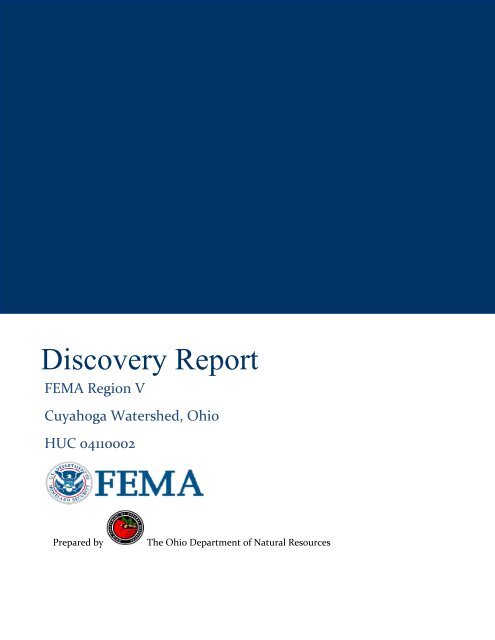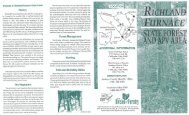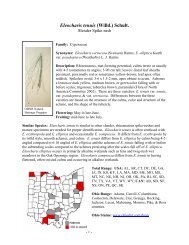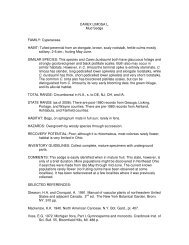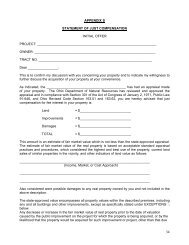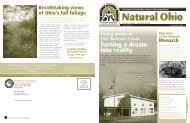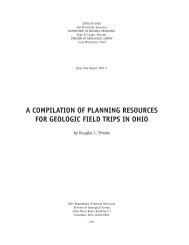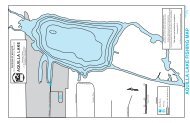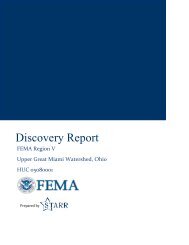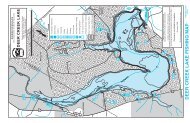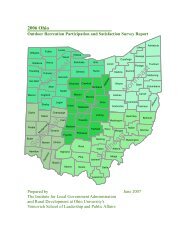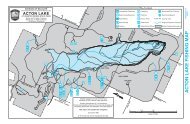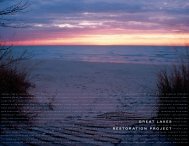Discovery Report - Ohio Department of Natural Resources
Discovery Report - Ohio Department of Natural Resources
Discovery Report - Ohio Department of Natural Resources
Create successful ePaper yourself
Turn your PDF publications into a flip-book with our unique Google optimized e-Paper software.
<strong>Discovery</strong> <strong>Report</strong><br />
FEMA Region V<br />
Cuyahoga Watershed, <strong>Ohio</strong><br />
HUC 04110002<br />
Prepared by<br />
The <strong>Ohio</strong> <strong>Department</strong> <strong>of</strong> <strong>Natural</strong> <strong>Resources</strong>
Project Area Community List<br />
Community Name CID<br />
Akron, City Of 390523<br />
Aquilla, Village <strong>of</strong> 390739<br />
Aurora, City <strong>of</strong> 390454<br />
Beachwood, City Of 390094<br />
Bedford Heights, City Of 390096<br />
Bedford, City Of 390095<br />
Boston Heights, Village Of 390749<br />
Brady Lake, Village <strong>of</strong> 390713<br />
Brecksville, City Of 390098<br />
Broadview Heights, City Of 390099<br />
Brook Park, City Of 390102<br />
Brooklyn Heights, Village Of 390101<br />
Brooklyn, City Of 390100<br />
Burton, Village <strong>of</strong> 390693<br />
Cleveland, City Of 390104<br />
Cuyahoga Falls, City Of 390526<br />
Cuyahoga Heights, Village Of 390654<br />
Fairlawn, City Of 390657<br />
Garfield Heights, City Of 390109<br />
Geauga County 390190<br />
Glenwillow, Village Of 390735<br />
Hartville, Village Of 390514<br />
Highland Hills, Village Of 390127<br />
Hudson, City Of 390660<br />
Independence, City Of 390111<br />
Kent, City <strong>of</strong> 390456<br />
Lakemore, Village Of 390527<br />
Linndale, Village Of 390069<br />
Macedonia, City Of 390750<br />
Mantua, Village <strong>of</strong> 390457<br />
Maple Heights, City Of 390114<br />
Medina County 390378<br />
Community Name CID<br />
Middleburg Heights, City Of 390117<br />
Middlefield, Village <strong>of</strong> 390192<br />
Mogadore, Village Of 390528<br />
Munroe Falls, City Of 390843<br />
Newburgh Heights, Village Of 390119<br />
North Randall, Village Of 390736<br />
North Royalton, City Of 390121<br />
Northfield, Village Of 390726<br />
Oakwood, Village Of 390122<br />
Orange, Village Of 390737<br />
Parma Heights, City Of 390124<br />
Parma, City Of 390123<br />
Peninsula, Village Of 390530<br />
Portage County 390453<br />
Ravenna, City <strong>of</strong> 390458<br />
Reminderville, Village Of 390855<br />
Richfield, Village Of 390083<br />
Seven Hills, City Of 390128<br />
Shaker Heights, City Of 390129<br />
Silver Lake, Village Of 390531<br />
Solon, City Of 390130<br />
Stark County 390780<br />
Stow, City Of 390532<br />
Streetsboro, City <strong>of</strong> 390797<br />
Sugar Bush Knolls, Village Of 390768<br />
Summit County 390781<br />
Tallmadge, City Of 390533<br />
Twinsburg, City Of 390534<br />
Valley View, Village Of 390134<br />
Walton Hills, Village Of 390636<br />
Warrensville Heights, City Of 390135<br />
i<br />
Cuyahoga Watershed <strong>Discovery</strong> <strong>Report</strong>, November 2011
Table <strong>of</strong> Contents<br />
I. Watershed Description…………………………………………………………. ii<br />
II. Project Description and Methodology………………………………………… 4<br />
III. Data Analysis…………………………………………………………………... 5<br />
i. Data that can be used for Flood Risk Products…………………………………7<br />
ii. Other Data and Information…………………………………………………….8<br />
IV. Risk MAP Needs………………………………………………………............15<br />
i. Floodplain Studies ............................................................................................. 15<br />
ii. Mitigation Projects ............................................................................................. 17<br />
iii. Compliance ........................................................................................................ 19<br />
iv. Communications ................................................................................................ 19<br />
V. Close…………………………………………………………………………...19<br />
VI. Appendix – <strong>Discovery</strong> Files……………………………………………...........20<br />
List <strong>of</strong> Tables<br />
I. Table 1. NFIP Participation Status……………………………………………...3<br />
II. Table 2. Data Collection for Cuyahoga Watershed…………..…………………6<br />
III. Table 3. USGS Gages…………………………………………………………...7<br />
IV. Table 4. Hazard Mitigation Plan Status………………………………………...8<br />
V. Table 5. Number <strong>of</strong> Repetitive Loss Structures by community…………..…9-10<br />
VI. Table 6: Community Assistance Visit status by community….…………...12-13<br />
VII. Table 7. Map Modernization Activity…………………………………………13<br />
VIII. Table 8. Mapping Needs……………………………………………...……16-17<br />
IX. Table 9. Areas <strong>of</strong> Mitigation Interest (AOMI)………...………………...…17-18<br />
List <strong>of</strong> Figures<br />
I. Figure 1. Project Area Map…….……………………………………………….2<br />
ii<br />
Cuyahoga Watershed <strong>Discovery</strong> <strong>Report</strong>, November 2011
I. Watershed Description<br />
The Cuyahoga River Watershed is located in northeast <strong>Ohio</strong>, with a drainage area <strong>of</strong> 812<br />
square miles. The 87 mile-long Cuyahoga River flows into Lake Erie in the City <strong>of</strong><br />
Cleveland. The principal tributaries to the Cuyahoga River are Tinkers Creek, Breakneck<br />
Creek, Big Creek, East Branch Cuyahoga River and Bridge Creek. The headwaters<br />
originate in south central Geauga County and flow in a southwesterly direction through<br />
Portage County and then flows west and then north through Summit County and the river<br />
continues north into Cuyahoga County. The watershed also drains the majority <strong>of</strong> Summit<br />
County, along with small portions <strong>of</strong> Cuyahoga, Geauga, Portage, Medina and Stark<br />
Counties. The limits <strong>of</strong> the <strong>Discovery</strong> project area are presented in Figure 1. Table 1<br />
includes the National Flood Insurance Program (NFIP) participation status <strong>of</strong> each<br />
community within the Cuyahoga Watershed.<br />
1<br />
Cuyahoga Watershed <strong>Discovery</strong> <strong>Report</strong>, November 2011
Figure 1. Project Area Map<br />
2<br />
Cuyahoga Watershed <strong>Discovery</strong> <strong>Report</strong>, November 2011
Table 1. NFIP Participation Status<br />
County Community Participating<br />
Cuyahoga Beachwood Y<br />
Bedford<br />
Bedford Heights<br />
Brecksville<br />
Broadview Heights<br />
Brook Park<br />
Brooklyn<br />
Brooklyn Heights<br />
Cleveland<br />
Cuyahoga County,<br />
Unincorporated<br />
Cuyahoga Heights<br />
Garfield Heights<br />
Glenwillow<br />
Highland Hills<br />
Independence<br />
Lakewood<br />
Linndale<br />
Maple Heights<br />
Middleburg<br />
Heights<br />
Newburgh Heights<br />
North Randall<br />
North Royalton<br />
Oakwood<br />
Orange<br />
Parma<br />
Parma Heights<br />
Seven Hills<br />
Shaker Heights<br />
Solon<br />
Valley View<br />
Walton Hills<br />
Warrensville<br />
Heights<br />
Y<br />
Y<br />
Y<br />
Y<br />
Y<br />
Y<br />
Y<br />
Y<br />
Y<br />
Y<br />
Y<br />
Y<br />
N<br />
Y<br />
Y<br />
N<br />
Y<br />
Y<br />
N<br />
N<br />
Y<br />
Y<br />
Y<br />
Y<br />
Y<br />
Y<br />
Y<br />
Y<br />
Y<br />
Y<br />
Y<br />
County Community Participating<br />
Geauga Aquilla Y<br />
Burton<br />
Geauga County,<br />
Unincorporated<br />
Middlefield<br />
Medina Medina County, Y<br />
Unincorporated<br />
Portage Aurora Y<br />
Brady Lake<br />
Kent<br />
Mantua<br />
Portage County,<br />
Unincorporated<br />
Ravenna<br />
Streetsboro<br />
Sugar Bush Knolls<br />
Stark Hartville N<br />
Stark County,<br />
Unincorporated<br />
Summit Akron Y<br />
Boston Heights<br />
Cuyahoga Falls<br />
Fairlawn<br />
Hudson<br />
Lakemore<br />
Macedonia<br />
Mogadore<br />
Munroe Falls<br />
Northfield<br />
Peninsula<br />
Reminderville<br />
Richfield<br />
Silver Lake<br />
Stow<br />
Summit County,<br />
Unincorporated<br />
Tallmadge<br />
Twinsburg<br />
N<br />
Y<br />
Y<br />
Y<br />
Y<br />
Y<br />
Y<br />
Y<br />
Y<br />
N<br />
Y<br />
Y<br />
Y<br />
Y<br />
Y<br />
Y<br />
Y<br />
Y<br />
Y<br />
N<br />
Y<br />
N<br />
Y<br />
Y<br />
Y<br />
Y<br />
Y<br />
Y<br />
3<br />
Cuyahoga Watershed <strong>Discovery</strong> <strong>Report</strong>, November 2011
II.<br />
Project Description and Methodology<br />
<strong>Discovery</strong> is the process <strong>of</strong> data collection, including information exchange between all<br />
governmental levels <strong>of</strong> stakeholders, spatial data presentation, and cooperative discussion<br />
with stakeholders to better understand the area, decide whether a flood risk project is<br />
appropriate, and if so, to collaborate on the project planning in detail. At this time,<br />
<strong>Discovery</strong> processes and requirements are still being defined; however, draft guidance is<br />
available from the draft Appendix I – <strong>Discovery</strong> (June 2011), the draft Meetings Guidance<br />
for FEMA Personnel (June 2011) and the FY11 <strong>Discovery</strong>, Statement <strong>of</strong> Priorities<br />
(January 2011). In addition, there are several draft tools and templates at various stages <strong>of</strong><br />
completion that were used to support the effort.<br />
Region V initiated a <strong>Discovery</strong> project in July 2011 for the Cuyahoga Watershed. The<br />
<strong>Discovery</strong> process involved coordination with watershed stakeholders, data collection and<br />
analysis, a meeting with stakeholders in the watershed, and development <strong>of</strong><br />
recommendations for Risk MAP projects based on an analysis <strong>of</strong> data and information<br />
gathered throughout the process.<br />
The initial phase in the <strong>Discovery</strong> process was establishing a Project Team made up <strong>of</strong><br />
local, state, and federal agencies. The Project Team for the Cuyahoga Watershed included<br />
representatives from:<br />
• FEMA Region V, Risk Analysis Branch<br />
• FEMA Region V, Floodplain Management and Insurance Branch<br />
• FEMA Region V, Hazard Mitigation Assistance Branch<br />
• <strong>Ohio</strong> <strong>Department</strong> <strong>of</strong> <strong>Natural</strong> <strong>Resources</strong> (ODNR)<br />
• <strong>Ohio</strong> Emergency Management Agency (OEMA)<br />
Project Team contact information and Project Team meeting minutes are provided in<br />
Appendix A. The Project Team worked together to compile the stakeholder list for the<br />
Cuyahoga watershed. <strong>Discovery</strong> Meeting invitations are presented in Appendix B. A list<br />
<strong>of</strong> the contacts made during this effort, including phone logs, notes from interviews,<br />
invitation lists, etc. are included in Appendices B and C to this document.<br />
ODNR coordinated with community <strong>of</strong>ficials and other watershed stakeholders through<br />
written invitations, phone calls and follow-up emails. The coordination included giving<br />
community <strong>of</strong>ficials information about the <strong>Discovery</strong> process. Communities were asked to<br />
identify “Areas <strong>of</strong> Concern” which could be addressed during the <strong>Discovery</strong> Meeting<br />
(mapping needs, desired mitigation projects, etc.) and added to the <strong>Discovery</strong> Geodatabase<br />
and Final <strong>Discovery</strong> Map.<br />
The second phase <strong>of</strong> the <strong>Discovery</strong> Project was the collection <strong>of</strong> relevant tabular and<br />
spatial data for all the communities within the watershed. The data was collected through<br />
4<br />
Cuyahoga Watershed <strong>Discovery</strong> <strong>Report</strong>, November 2011
online resources, Federal and State sources, and interviews with cooperating communities.<br />
The collected data was used to evaluate both previous and current flooding concerns, while<br />
determining the vital areas requiring mapping needs. Section IV, Data Analysis, provides<br />
a more in-depth look at the collected data.<br />
The third phase was to hold watershed-wide <strong>Discovery</strong> Meetings and facilitate discussion<br />
and data analysis <strong>of</strong> study needs, mitigation project needs, desired compliance support, and<br />
local flood risk awareness efforts. Two (2) watershed-wide <strong>Discovery</strong> Meetings were held<br />
on July 5, 2011 in Cleveland Heights and Hudson, <strong>Ohio</strong>. The discussion was stimulated<br />
using the <strong>Discovery</strong> Geodatabase display <strong>of</strong> relevant data. Attendees, including all affected<br />
communities and selected other stakeholders, cooperatively identified possible solutions<br />
for the Areas <strong>of</strong> Concern shown on the <strong>Discovery</strong> Meeting Map. Solutions included<br />
recommendations <strong>of</strong> floodplain studies, mitigation projects, compliance issues, and ideas<br />
on how to improve the local flood risk communication programs.<br />
Copies <strong>of</strong> the <strong>Discovery</strong> Meeting Presentations, sign in sheets, handouts, meeting notes<br />
and meeting feedback forms are presented in Appendices, C, D, E and F, respectively.<br />
The fourth phase <strong>of</strong> the <strong>Discovery</strong> effort involved an analysis <strong>of</strong> the data and information<br />
collected and discussed at the meeting, and recommendations as to the future relationship<br />
and activities between FEMA and the watershed communities. The Final <strong>Discovery</strong> Map,<br />
presented in Appendix G, indicates desired study areas and mitigation project locations,<br />
and the <strong>Discovery</strong> <strong>Report</strong> documents the results <strong>of</strong> data collection and conversation. If a<br />
Risk MAP project is to be initiated in this watershed, <strong>Discovery</strong> will be concluded with the<br />
finalization <strong>of</strong> a project scope and signed Project Charters, which indicate that all affected<br />
stakeholders agree to the terms <strong>of</strong> a funded project, including communication and data<br />
responsibilities.<br />
III.<br />
Data Analysis<br />
<strong>Discovery</strong> data collection entailed a massive collection <strong>of</strong> tabular and spatial data for all<br />
stakeholder communities from Federal, State and Local sources. A list <strong>of</strong> the data<br />
collected, the deliverable or product in which the data are included, and the source <strong>of</strong> the<br />
data is presented in Table 2. In addition, Data Analysis is divided between two sections:<br />
one section listing the data that can be used for Risk MAP products (regulatory and<br />
non-regulatory) and, one section listing the other data and information that helped the<br />
Project Team to form a more holistic understanding <strong>of</strong> this watershed.<br />
5<br />
Cuyahoga Watershed <strong>Discovery</strong> <strong>Report</strong>, November 2011
Table 2. Data Collection for the Cuyahoga Watershed<br />
Data Types Deliverable/ Product Source<br />
Mitigation Plans Status Table in <strong>Report</strong> FEMA Regional Office, OEMA<br />
Mitigation Projects<br />
Table in <strong>Report</strong><br />
Data.gov: FEMA Hazard<br />
Mitigation Program Summary,<br />
OEMA<br />
Repetitive Loss<br />
Table in <strong>Report</strong><br />
Community Information System<br />
(CIS), OEMA<br />
Declared Disasters<br />
<strong>Discovery</strong> Maps<br />
Data.gov: FEMA Disaster<br />
Declarations Summary<br />
Past flood claims and repetitive<br />
loss properties<br />
Table in <strong>Report</strong><br />
FEMA R5 and/or ODNR<br />
HUC-8 Watershed <strong>Discovery</strong> Map Geo-Database<br />
USGS National Hydrography<br />
Dataset (NHD)<br />
HUC-12 Watersheds <strong>Discovery</strong> Map Geo-Database<br />
National Resource Conservation<br />
Service (NRCS)<br />
Jurisdictional Boundaries <strong>Discovery</strong> Map Geo-Database FEMA and ODNR<br />
State lands<br />
<strong>Discovery</strong> Map Geo-Database<br />
<strong>Ohio</strong> <strong>Department</strong> <strong>of</strong> <strong>Natural</strong><br />
<strong>Resources</strong> (ODNR)<br />
Federal lands <strong>Discovery</strong> Map Geo-Database USGS National Atlas<br />
Transportation Major and Minor <strong>Discovery</strong> Map Geo-Database<br />
FEMA<br />
Stream lines<br />
<strong>Discovery</strong> Map Geo-Database<br />
National Hydrography Dataset<br />
(NHD ) and FEMA<br />
Study Needs<br />
<strong>Discovery</strong> Map Geo-Database<br />
Coordinated Needs Management<br />
System (CNMS)<br />
Topographic data<br />
<strong>Ohio</strong> Statewide Imagery Program<br />
<strong>Discovery</strong> Map Geo-Database<br />
(OSIP)<br />
HAZUS - Average Annualized<br />
Loss (AAL)<br />
<strong>Discovery</strong> Map Geo-Database<br />
STARR<br />
Local mitigation plans <strong>Discovery</strong> Map Geo-Database OEMA<br />
State mitigation plans <strong>Discovery</strong> Map Geo-Database<br />
ODPS - <strong>Ohio</strong> Emergency<br />
Management Agency (OEMA)<br />
Regional flood control structures <strong>Discovery</strong> Map Geo-Database<br />
<strong>Ohio</strong> <strong>Department</strong> <strong>of</strong> <strong>Natural</strong><br />
<strong>Resources</strong> (ODNR) and FEMA<br />
Stream Gages <strong>Discovery</strong> Map Geo-Database U.S. Geological Survey (USGS)<br />
Flooded Structures <strong>Discovery</strong> Map Geo-Database<br />
<strong>Ohio</strong> <strong>Department</strong> <strong>of</strong> <strong>Natural</strong><br />
<strong>Resources</strong> (ODNR)<br />
Effective study data <strong>Discovery</strong> Map Geo-Database FEMA's County DFIRM Data<br />
Orthophotography<br />
<strong>Ohio</strong> Statewide Imagery Program<br />
<strong>Discovery</strong> Map Geo-Database<br />
(OSIP)<br />
Contacts<br />
Excel spreadsheet<br />
Local websites, State/FEMA<br />
updates<br />
6<br />
Cuyahoga Watershed <strong>Discovery</strong> <strong>Report</strong>, November 2011
i. Data that can be used for Flood Risk Products<br />
Topographic and Imagery Data<br />
As shown on the Final <strong>Discovery</strong> Map, LiDAR elevation data and digital<br />
orthophotography is available for the project area provided by the <strong>Ohio</strong> Geographically<br />
Referenced Information Program (OGRIP), as part <strong>of</strong> the <strong>Ohio</strong> Statewide Imagery<br />
Program (OSIP). The goal <strong>of</strong> OSIP I was to develop and maintain a seamless statewide<br />
base map. OSIP is an initiative partnered by several State Agencies (i.e. ODOT, ODNR)<br />
through OGRIP. Data from this project forms the foundation <strong>of</strong> the statewide base map,<br />
and was developed primarily to support multi-use applications, including homeland<br />
security, emergency management, economic development, and the business <strong>of</strong><br />
government. The digital orthophotography consists <strong>of</strong> MrSID Images produced at 1-foot<br />
pixel resolution at a 30:1 compression ratio. The LiDAR elevation data consists <strong>of</strong> Digital<br />
Elevation Model (DEM) raster tiles acquired to meet +/- 1-foot vertical accuracy. This is<br />
suitable for rectification <strong>of</strong> digital orthophotography and for the creation <strong>of</strong> 2- and 5-foot<br />
contours (with the addition <strong>of</strong> 3D compiled breaklines). OSIP products within the<br />
Cuyahoga Watershed were collected during leaf-<strong>of</strong>f conditions between 2006 and 2008. In<br />
February 2011, <strong>Ohio</strong> initiated a continuation <strong>of</strong> the OSIP program. OSIP II imagery will<br />
be acquired beginning in spring 2011 and continuing through 2014. For OSIP II county<br />
specific acquisition information as <strong>of</strong> May 9, 2011, see Appendix H.<br />
USGS Gages<br />
ODNR has identified several USGS stream gages in the watershed. The locations <strong>of</strong> the<br />
gages are shown on the <strong>Discovery</strong> Map and a summary is presented in Table 3.<br />
Table 3. USGS Gages<br />
Gage Number<br />
Station Name and Location<br />
Years <strong>of</strong> Record<br />
(Peaks)<br />
4206000 Cuyahoga River at Old Portage OH 86<br />
4206220 Yellow Creek at Botzum OH 19<br />
4202000 Cuyahoga River at Hiram Rapids OH 73<br />
4207200 Tinkers Creek at Bedford OH 47<br />
4208000 Cuyahoga River at Independence OH 81<br />
4208460 Mill Creek at Garfield Hts OH 7<br />
4208504 Cuyahoga River near Newburgh Heights OH 3<br />
Average Annualized Loss (AAL) Data<br />
FEMA has conducted a Level 1 Hazus flood analysis to determine average annualized<br />
losses (AAL) for the project area. This analysis was based on USGS 30-meter DEM data<br />
and Hazus s<strong>of</strong>tware default inventory data. The Hazus riverine hydrology analysis used<br />
default USGS regression equations to estimate the peak flows for selected return periods<br />
and the USGS topographic data to conduct normal depth calculations for flood depth grids.<br />
The loss estimation for the AAL data was then conducted to produce loss calculations at<br />
the U.S. census block level.<br />
7<br />
Cuyahoga Watershed <strong>Discovery</strong> <strong>Report</strong>, November 2011
The AAL data is symbolized on the <strong>Discovery</strong> Map as varying levels <strong>of</strong> risk. During the<br />
<strong>Discovery</strong> meeting, the Level 1 analysis results will be validated by stakeholders to<br />
identify potential sites for Refined Analyses.<br />
ii. Other Data and Information<br />
Mitigation Plans/Status<br />
Hazard Mitigation Plans (HMPs) are prepared to assist communities to reduce their risk to<br />
natural hazard events. The plans are used to develop strategies for risk reduction and to<br />
serve as a guide for all mitigation activities in the given county or community. The<br />
available HMPs obtained and reviewed for this <strong>Discovery</strong> Project are presented in Table 4.<br />
Table 4. Hazard Mitigation Plan Status<br />
County/Community<br />
Hazus<br />
Hazard<br />
Mitigation<br />
Plan<br />
Issue<br />
Date<br />
Expiration<br />
Date<br />
Cuyahoga County N Y 1/21/2007 1/21/2012<br />
Geauga County N Y* 12/22/2005 12/22/2010<br />
Medina County N Y* 8/25/2006 8/25/2011<br />
Portage County N Y 8/6/2007 8/6/2012<br />
Stark County N Y* 6/23/2006 6/23/2011<br />
Summit County N Y 4/9/2007 4/9/2012<br />
*Hazard Mitigation plan is expired.<br />
Critical facilities are the facilities that can impact the delivery <strong>of</strong> vital services, cause<br />
greater damages to other sectors <strong>of</strong> a community, or put special populations at risk. The<br />
assessment <strong>of</strong> the flood risk posed to critical facilities within the watershed is an important<br />
aspect <strong>of</strong> the HMPs. Critical facilities that are located within the 1-percent-annual-chance<br />
floodplain were quantified and identified as at-risk structures. The exact number <strong>of</strong> critical<br />
facilities that are considered at-risk is not quantifiable due to the limited detail presented in<br />
the HMPs. The number <strong>of</strong> critical facilities estimated to be within the 1-percent-annualchance<br />
floodplain was determined by overlaying Hazard Maps included in the HMP’s with<br />
the latest flood hazard data. However, the risk <strong>of</strong> flood damage is limited by the detail and<br />
accuracy <strong>of</strong> the most recent flood map.<br />
A repetitive loss structure is a term associated with the National Flood Insurance Program<br />
(NFIP). For Flood Mitigation Assistance (FMA) program purposes, a repetitive loss<br />
structure is one that is covered by a flood insurance contract under the NFIP, that has<br />
suffered flood damage on two or more occasions over a 10-year period, ending on the date<br />
when a second claim is made, in which the cost to repair the flood damage, on average,<br />
equals or exceeds 25% <strong>of</strong> the market-value <strong>of</strong> the structure at the time <strong>of</strong> each flood loss<br />
event. In terms <strong>of</strong> the Community Rating System (CRS) <strong>of</strong> the NFIP, a repetitive loss<br />
property is any property, which the NFIP has paid two or more flood claims <strong>of</strong> $1,000 or<br />
more, in any given 10-year period since 1978. A repetitive loss structure is important to the<br />
NFIP, since structures that flood frequently put a strain on the flood insurance fund. It<br />
8<br />
Cuyahoga Watershed <strong>Discovery</strong> <strong>Report</strong>, November 2011
should also be important to a community because <strong>of</strong> the disruption and threat to residents’<br />
lives by the continual flooding.<br />
Specific details regarding repetitive loss structures within the floodplain were not made<br />
available in the available HMPs. The locations <strong>of</strong> repetitive loss structures presented on the<br />
<strong>Discovery</strong> Map were determined by rectifying the HMP’s Hazard Maps to the <strong>Discovery</strong><br />
Map’s base map data. The exact locations and numbers <strong>of</strong> repetitive loss structures have<br />
been summarized with caution due to the lack <strong>of</strong> detail in the HMPs and Hazard Maps.<br />
Areas that have suffered multiple repetitive losses are some <strong>of</strong> the most important areas <strong>of</strong><br />
mitigation interest.<br />
Table 5: Number <strong>of</strong> Repetitive Loss Structures by community<br />
Community County # Rep Loss Structures<br />
Beachwood Cuyahoga 0<br />
Bedford Cuyahoga 0<br />
Bedford Heights Cuyahoga 25<br />
Brecksville Cuyahoga 2<br />
Broadview Heights Cuyahoga 2<br />
Brook Park Cuyahoga 0<br />
Brooklyn Cuyahoga 0<br />
Brooklyn Heights Cuyahoga 0<br />
Cleveland Cuyahoga 18<br />
Cuyahoga County,<br />
Cuyahoga 10<br />
Unincorporated<br />
Cuyahoga Heights Cuyahoga 0<br />
Garfield Heights Cuyahoga 11<br />
Glenwillow Cuyahoga 0<br />
Highland Hills Cuyahoga 0<br />
Independence Cuyahoga 96<br />
Lakewood Cuyahoga 11<br />
Linndale Cuyahoga 0<br />
Maple Heights Cuyahoga 0<br />
Middleburg Heights Cuyahoga 11<br />
Newburgh Heights Cuyahoga 0<br />
North Randall Cuyahoga 0<br />
North Royalton Cuyahoga 7<br />
Oakwood Cuyahoga 2<br />
Orange Cuyahoga 0<br />
Parma Cuyahoga 2<br />
Parma Heights Cuyahoga 0<br />
Seven Hills Cuyahoga 2<br />
Shaker Heights Cuyahoga 0<br />
Solon Cuyahoga 2<br />
Valley View Cuyahoga 149<br />
Walton Hills Cuyahoga 2<br />
Warrensville Heights Cuyahoga 0<br />
9<br />
Cuyahoga Watershed <strong>Discovery</strong> <strong>Report</strong>, November 2011
Table 5 (Continued): Number <strong>of</strong> Repetitive Loss Structures by community<br />
Community County # Rep Loss Structures<br />
Aquilla Geauga 0<br />
Burton Geauga 0<br />
Geauga County, Unincorporated Geauga 9<br />
Middlefield Geauga 0<br />
Medina County, Unincorporated Medina 13<br />
Aurora Portage 4<br />
Brady Lake Portage 0<br />
Kent Portage 0<br />
Mantua Portage 0<br />
Portage County, Unincorporated Portage 6<br />
Ravenna Portage 0<br />
Streetsboro Portage 0<br />
Sugar Bush Knolls Portage 0<br />
Hartville Stark 0<br />
Stark County, Unincorporated Stark 44<br />
Akron Summit 5<br />
Boston Heights Summit 0<br />
Cuyahoga Falls Summit 0<br />
Fairlawn Summit 2<br />
Hudson Summit 2<br />
Lakemore Summit 0<br />
Macedonia Summit 0<br />
Mogadore Summit 0<br />
Munroe Falls Summit 9<br />
Northfield Summit 0<br />
Peninsula Summit 0<br />
Reminderville Summit 0<br />
Richfield Summit 0<br />
Silver Lake Summit 0<br />
Stow Summit 6<br />
Summit County, Unincorporated Summit 25<br />
Tallmadge Summit 0<br />
Twinsburg Summit 0<br />
Numerous locations <strong>of</strong> roads overtopping during flood events were identified during the<br />
data collection and <strong>Discovery</strong> Meeting process.<br />
Numerous dams exist within the watershed, but are not mentioned in the HMPs as flood<br />
control structures. According to the ODNR database, sixteen (16) Class I dams are located<br />
within the watershed and owned/operated by state or federal agencies.<br />
The overall goals <strong>of</strong> the reviewed HMP’s were found to be consistent; however, specific<br />
methods for implementation <strong>of</strong> these goals and locations <strong>of</strong> specific projects were not<br />
readily available. These goals include:<br />
10<br />
Cuyahoga Watershed <strong>Discovery</strong> <strong>Report</strong>, November 2011
• Educate the citizens <strong>of</strong> each county to increase awareness <strong>of</strong> flooding and where to<br />
seek safety during flood events<br />
• Provide adequate shelters where citizens can seek safety from severe weather and<br />
flooding<br />
• Improve the warning systems and radio communications throughout the county<br />
• Expedite the cleanup process through coordination and equipment acquisition<br />
• Update countywide NFIP maps<br />
• Purchase or flood pro<strong>of</strong> repetitive loss structures<br />
• Develop map <strong>of</strong> infrastructure concerns<br />
Some <strong>of</strong> the county’s/community’s HMPs included the locations and number <strong>of</strong> repetitive<br />
loss structures while other plans left this information out. This inconsistency in information<br />
holds true with the location and number <strong>of</strong> critical facilities found within the 1-percentannual-chance<br />
floodplain.<br />
Successful Mitigation Projects<br />
There have been two recent mitigation projects in the watershed. In 2006, North Royalton<br />
was awarded a grant from FEMA for the acquisition <strong>of</strong> four residential structural that were<br />
located in the floodplain <strong>of</strong> Baldwin Creek. Areas <strong>of</strong> the Baldwin Creek have eroded and<br />
been filled in by soil to the extent where there is no recognizable channel <strong>of</strong> water. The<br />
creek’s capacity and ability to drain and convey the flow <strong>of</strong> water has diminished. In 2010,<br />
Valley View was also awarded a pre-disaster mitigation grant to reduce future cost<br />
incurred from flood damages. This grant will allow thirteen homes to be elevated.<br />
Coordinated Needs Management Strategy (CNMS) and NFIP Mapping Study Needs<br />
Analysis <strong>of</strong> the CNMS data for the Cuyahoga Watershed is finished. Analyzed studies<br />
have been identified as “VALID” or “UNVERIFIED”. The current CNMS geospatial data<br />
is presented on the Final <strong>Discovery</strong> Map.<br />
Community Rating System (CRS)<br />
The Village <strong>of</strong> Orange and Medina County are the only communities in the Cuyahoga<br />
Watershed that participate in the CRS program.<br />
Levees<br />
No levees have been identified within the Cuyahoga watershed within FEMAs Mid-Term<br />
Levee Inventory database<br />
Floodplain Management/Community Assistance Visits<br />
FEMA uses a number <strong>of</strong> key tools to determine a community’s compliance with the<br />
minimum regulations <strong>of</strong> the National Flood Insurance Program. Among them are<br />
Community Assistance Visits (CAVs), the Letter <strong>of</strong> Map Change (LOMC) process, and<br />
Submit-for-Rates. These tools help assess a community’s implementation <strong>of</strong> their Flood<br />
Damage Reduction Regulations and identify any floodplain management deficiencies and<br />
violations. The CAV is a visit to a community by a FEMA staff member or staff <strong>of</strong> a state<br />
11<br />
Cuyahoga Watershed <strong>Discovery</strong> <strong>Report</strong>, November 2011
agency on behalf <strong>of</strong> FEMA that serves the dual purpose <strong>of</strong> providing technical assistance<br />
to the community and assuring that the community is adequately enforcing its floodplain<br />
management regulations. Potential violations may be identified during the CAV visit as a<br />
result <strong>of</strong> touring the floodplain, inspecting community permit files, and meeting with local<br />
appointed and elected <strong>of</strong>ficials. For most recent CAV information, see Table 6.<br />
Active CAV’s are the communities that are currently going through the CAV process.<br />
Communities that have gone through a CAV and have provided all the necessary<br />
information to show they are in compliance are listed as Closed. FEMA CAV’s can be<br />
indicative <strong>of</strong> unresolved issues and has been turned over to FEMA for follow up and<br />
possible enforcement action against the community if the outstanding issues are not<br />
resolved. Communities with FEMA referred CAV’s include the Cities <strong>of</strong> Bedford Heights,<br />
Independence and Lakewood 1 .<br />
Violations can also be discovered when LOMR-F applications depict a non-compliant<br />
structure based on elevation data; or can be found through Submit-for-Rate requests, which<br />
occur when a structure applies for flood insurance but has been identified as being two or<br />
more feet below Base Flood Elevation (BFE). Elevation comparisons identified through<br />
LOMR-F applications and Submit-for-Rates imply structures were not built compliantly. 1<br />
Communities with Submit-for-Rate issues include cities <strong>of</strong> Valley View, Aurora, Kent,<br />
Akron and Stow and the counties <strong>of</strong> Medina, Portage and Stark 1 . If administrative<br />
problems or potential violations are identified, the community will be notified and given<br />
the opportunity to correct those administrative procedures and remedy the violations to the<br />
maximum extent possible within established deadlines. FEMA or the state will work with<br />
the community to help them bring their program into compliance with NFIP requirements.<br />
In extreme cases where the community does not take action to bring itself into compliance,<br />
FEMA may initiate an enforcement action against the community. No Risk MAP needs<br />
regarding compliance were identified.<br />
Table 6: Community Assistance Visit status by community<br />
County Community CID Recent CAV date CAV Status*<br />
Cuyahoga Beachwood 390094 6/6/1995 -<br />
Bedford 390095 - C<br />
Bedford Heights 390096 5/8/2006 F<br />
*A= Active, C= Closed, F= Referred to FEMA, NP = Non Participating<br />
1 This list may not encompass all communities within the watershed with violations.<br />
Similarly, communities may have additional violations not addressed above<br />
12<br />
Cuyahoga Watershed <strong>Discovery</strong> <strong>Report</strong>, November 2011
Table 6(Continued): Community Assistance Visit status by community<br />
County Community CID Recent CAV date CAV Status*<br />
Brecksville 390098 - C<br />
Broadview Heights 390099 - -<br />
Broadview Heights 390099 - -<br />
Brook Park 390102 - -<br />
Brooklyn 390100 - -<br />
Brooklyn Heights 390101 7/12/1995 C<br />
Cleveland 390104 6/3/1998 -<br />
Cuyahoga County,<br />
Unincorporated 390766 - -<br />
Cuyahoga Heights 390654 - -<br />
Garfield Heights 390109 4/26/1990 -<br />
Glenwillow 390735 12/28/1995 -<br />
Highland Hills 390127 NP NP<br />
Independence 390111 5/15/2006 F<br />
Lakewood 390112 7/21/1993 F<br />
Cuyahoga Linndale 390069 NP NP<br />
Maple Heights 390114 - -<br />
Middleburg Heights 390117 - -<br />
Newburgh Heights 390119 - -<br />
North Randall 390736 NP NP<br />
North Royalton 390121 10/27/2004 A<br />
Oakwood 390122 - -<br />
Orange 390737 4/20/2000 C<br />
Parma 390123 - -<br />
Parma Heights 390124 1/27/1999 C<br />
Seven Hills 390128 - -<br />
Shaker Heights 390129 3/17/1994 -<br />
Solon 390130 6/24/1994 -<br />
Valley View 390134 6/8/2006 C<br />
Walton Hills 390636 - -<br />
Warrensville Heights 390135 6/29/1995 -<br />
Geauga Aquilla 390739 11/6/1995 -<br />
Burton 390693 NP NP<br />
Geauga County,<br />
Unincorporated 390190 12/9/1997 -<br />
Middlefield 390192 3/12/1991 -<br />
Medina Medina County,<br />
Unincorporated 390378 11/9/2005 C<br />
*A= Active, C= Closed, F= Referred to FEMA, NP = Non Participating<br />
13<br />
Cuyahoga Watershed <strong>Discovery</strong> <strong>Report</strong>, November 2011
Table 6(Continued): Community Assistance Visit status by community<br />
County Community CID Recent CAV date CAV Status*<br />
Aurora 390454 7/2/2009 C<br />
Brady Lake 390713 NP NP<br />
Kent 390456 4/30/1996 -<br />
Mantua 390457 11/7/2002 F<br />
Portage Portage County,<br />
Unincorporated 390453 5/2/2000 C<br />
Ravenna 390458 2/1/2001 C<br />
Streetsboro 390797 12/11/2003 C<br />
Sugar Bush Knolls 390768 NP NP<br />
Stark Hartville 390514 NP NP<br />
Stark County,<br />
Unincorporated 390780 3/15/2007 C<br />
Summit Akron 390523 5/3/2000 C<br />
Boston Heights 390749 4/20/1995 -<br />
Cuyahoga Falls 390526 4/20/1995 -<br />
Fairlawn 390657 9/24/2009 A<br />
Hudson 390660 9/28/2009 A<br />
Lakemore 390527 - -<br />
Macedonia 390750 - -<br />
Mogadore 390528 9/13/2001 C<br />
Munroe Falls 390843 4/8/1998 -<br />
Northfield 390726 NP NP<br />
Peninsula 390530 8/1/2001 C<br />
Reminderville 390855 6/19/1995 -<br />
Richfield 390083 - -<br />
Silver Lake 390531 5/10/2001 C<br />
Stow 390532 12/8/2000 C<br />
Summit County,<br />
Unincorporated 390781 9/30/2010 C<br />
Tallmadge 390533 12/14/1995 -<br />
Twinsburg 390534 11/21/1995 -<br />
*A= Active, C= Closed, F= Referred to FEMA, NP = Non Participating<br />
Regulatory Mapping<br />
Cuyahoga Watershed communities have all had recent countywide map updates as part <strong>of</strong><br />
FEMA’s Map Modernization Program. The effective dates <strong>of</strong> the most recent county-wide<br />
projects are presented on the <strong>Discovery</strong> Map and below in Table 7. The effective data is a<br />
combination <strong>of</strong> both detailed and approximate analysis with varying vintage dates.<br />
14<br />
Cuyahoga Watershed <strong>Discovery</strong> <strong>Report</strong>, November 2011
Table 7. Map Modernization Activity<br />
County Status Effective Date<br />
Cuyahoga Effective 12/3/2010<br />
Geauga Effective 6/16/2009<br />
Medina Effective 8/4/2008<br />
Portage Effective 8/18/2009<br />
Stark Effective 9/29/2011<br />
Summit Effective 7/20/2009<br />
IV.<br />
Risk MAP Needs<br />
The results <strong>of</strong> the data collection and analysis were thoroughly discussed at the <strong>Discovery</strong><br />
Meeting. The following sections include issues and situations that exist in the Cuyahoga<br />
Watershed communities that can be considered Risk MAP Needs, to be addressed with Risk<br />
MAP projects. Details and background on all issues can be found in the interview notes,<br />
meeting notes, and other files included in the appendices.<br />
i. Floodplain Studies<br />
All <strong>of</strong> the counties located in the Cuyahoga Watershed have undergone recent countywide<br />
DFIRM projects; however, not all <strong>of</strong> these projects included new Zone A studies and some<br />
approximate flood hazards were digitally converted.<br />
As shown on the Final <strong>Discovery</strong> Map, recent LiDAR and imagery data meeting FEMA’s<br />
Guidelines and Specifications have been developed for the entire <strong>Discovery</strong> Project Area.<br />
As shown on the Final <strong>Discovery</strong> Map, numerous study reaches have been classified as<br />
“UNVERIFIED” during the CNMS process.<br />
At the <strong>Discovery</strong> Meeting, several areas were identified by community <strong>of</strong>ficials as needing<br />
an updated detailed or approximate study. The City <strong>of</strong> Kent is planning to update flood<br />
studies on Fish Creek and other rivers within the community. The community funded<br />
projects provide an opportunity to leverage the data for Risk MAP products.<br />
Based on the results <strong>of</strong> the Stakeholder Coordination, Data Analysis and <strong>Discovery</strong><br />
Meeting, proposed Study Areas in the Cuyahoga have been identified in Table 8. The<br />
specific locations <strong>of</strong> these Study Areas are presented on the Final <strong>Discovery</strong> Map. A<br />
complete list <strong>of</strong> mapping needs is located in Appendix G.<br />
15<br />
Cuyahoga Watershed <strong>Discovery</strong> <strong>Report</strong>, November 2011
Table 8. Mapping Needs<br />
FLOODING SOURCE<br />
STUDY<br />
LENGTH<br />
(miles) STUDY TYPE PRIORITY<br />
Tinkers Creek 8.53 Redelineated Very High Priority<br />
Kelsey Creek 1.95 Redelineated Very High Priority<br />
Plum Creek 4.64 Redelineated Very High Priority<br />
Tinkers Creek Tributary 2 3.05 Redelineated Very High Priority<br />
Cuyahoga River 7.49 Redelineated Very High Priority<br />
Cuyahoga River 0.46 Updated Approximate High Priority<br />
Cuyahoga River 4.38 Redelineated High Priority<br />
Cuyahoga River 10.06 Redelineated High Priority<br />
Cuyahoga River 6.39 Redelineated Medium Priority<br />
Cuyahoga River 1.83 Redelineated Medium Priority<br />
Springfield Lake Outlet 2.88 Redelineated Medium Priority<br />
Mud Brook Tributary 1 0.83 New Detailed Medium Priority<br />
Little Cuyahoga River 6.62 Redelineated Medium Priority<br />
Indian Creek 4.43 Updated Detailed Medium Priority<br />
Hudson Ditch 2.51 Redelineated Medium Priority<br />
Tinkers Creek 2.22 Redelineated Medium Priority<br />
Tinkers Creek 3.42 Redelineated Medium Priority<br />
Countrymans Creek/Big Creek Tributary 2.16 Redelineated Medium Priority<br />
Big Creek 3.62 Redelineated Medium Priority<br />
Cuyahoga River 0.10 Updated Approximate Medium Priority<br />
Cuyahoga River 0.12 Updated Approximate Medium Priority<br />
Cuyahoga River 0.13 Updated Approximate Medium Priority<br />
Cuyahoga River 0.15 Updated Approximate Medium Priority<br />
Cuyahoga River 0.16 Updated Approximate Medium Priority<br />
Cuyahoga River 0.16 Updated Approximate Medium Priority<br />
Cuyahoga River 0.33 Updated Approximate Medium Priority<br />
Cuyahoga River 6.70 Updated Approximate Medium Priority<br />
Cuyahoga River 7.66 Updated Approximate Medium Priority<br />
Little Cuyahoga River 1.66 Updated Approximate Medium Priority<br />
Little Cuyahoga River 1.70 Updated Approximate Medium Priority<br />
Sand Run 0.01 Updated Approximate Medium Priority<br />
Sand Run 2.75 Updated Approximate Medium Priority<br />
Tinkers Creek 3.06 Updated Approximate Medium Priority<br />
Walnut Creek 1.11 Updated Approximate Medium Priority<br />
Wingfoot Lake Outlet 0.44 Updated Approximate Medium Priority<br />
Unnamed 0.27 Updated Approximate Medium Priority<br />
Unnamed 0.38 Updated Approximate Medium Priority<br />
16<br />
Cuyahoga Watershed <strong>Discovery</strong> <strong>Report</strong>, November 2011
Table 8(Continued). Mapping Needs<br />
STUDY<br />
LENGTH<br />
FLOODING SOURCE<br />
(miles) STUDY TYPE PRIORITY<br />
Unnamed 0.61 Updated Approximate Medium Priority<br />
Unnamed 0.70 Updated Approximate Medium Priority<br />
Pond Brook 1.24 Redelineated Medium Priority<br />
Cuyahoga River 1.41 Redelineated Medium Priority<br />
Tinkers Creek 0.50 Redelineated Medium Priority<br />
Tinkers Creek 1.28 Redelineated Medium Priority<br />
Mill Creek 2.11 Redelineated Medium Priority<br />
ii. Mitigation Projects<br />
There is an ongoing mitigation project underway in Valley View which is situated along<br />
the Cuyahoga River. This grant was awarded in July 2010. Other areas <strong>of</strong> potential<br />
mitigation interest were also obtained from the local <strong>of</strong>ficials and those are in Table 9.<br />
Table 9: Areas <strong>of</strong> Mitigation Interest (AOMI)<br />
Community County Flooding Source Comments<br />
Portage County Portage Tinkers Creek Flooding overtops road<br />
Brecksville Cuyahoga Cuyahoga River<br />
Flooding along Riverview Rd. between Snowville Rd. and the<br />
County line<br />
Brecksville Cuyahoga Cuyahoga River Culvert Issue near Riverview Rd and Vaughn Rd.<br />
Twinsburg Summit Tinkers Creek Ravenna Rd. is overtopped<br />
Twinsburg Summit Tinkers Creek Parking lot flooding<br />
Twinsburg Summit Tinkers Creek Mild flooding 2-3 structures<br />
Reminderville Portage Aurora Pond Repetitive Loss and Mitigation opportunities<br />
Broadview Heights Cuyahoga Unnamed Stream Repetitive flooding area<br />
Oakwood Cuyahoga Unknown Flooding on Macedonia Rd. near address 7647<br />
Independence Cuyahoga Cuyahoga River Flooding on Lower Brookside Rd. west <strong>of</strong> Riverview Rd.<br />
Solon Cuyahoga Tinkers Creek Tributary 2 Flooding issue at entrance to treatment plant<br />
Oakwood Cuyahoga Tinkers Creek Flooding at Richmond Rd. on Tinkers Creek<br />
Solon Cuyahoga Unknown Flooding issue on SR 91 at Norfolk and Southern overpass<br />
Parma Cuyahoga West Creek Flooding near Ridgewood Rd.<br />
Cleveland Cuyahoga Cuyahoga River Canal Road Flooding issues<br />
Valley View Cuyahoga Cuyahoga River<br />
Repetitive flooding area- some <strong>of</strong> this area has been recently<br />
mitigated<br />
Bedford Cuyahoga Wood Creek Flooding near Broadway<br />
Valley View Cuyahoga Cuyahoga River<br />
Canal Road storm sewer system between I-480 and Fosdick<br />
Road overwhelmed by rain<br />
Parma Cuyahoga Unknown Repetitive flooded homes<br />
Bedford Heights Cuyahoga Hawthorne Creek<br />
Consistent Flooding at the termination <strong>of</strong> approximately 102"<br />
stormwater drain at 5626 Richmond Rd.<br />
17<br />
Cuyahoga Watershed <strong>Discovery</strong> <strong>Report</strong>, November 2011
Table 9 (Continued): Areas <strong>of</strong> Mitigation Interest (AOMI)<br />
Community County Flooding Source Comments<br />
Solon Cuyahoga Tinkers Creek Tributary 2 Industrial area- frequent flooding<br />
Bedford Cuyahoga Wood Creek Flooding along Cresswell Avenue<br />
Valley View Cuyahoga Cuyahoga River 96" Storm sewer along I-480 is filled with silt<br />
Parma Cuyahoga Big Creek Cleveland Trailer Park flooding, GM retention pond issues<br />
Solon Cuyahoga Hawthorne Creek Flooding issue near Cannon Rd along Hawthorne Creek<br />
Maple Heights Cuyahoga Wood Creek Flooding on Waterbury St.<br />
Solon Cuyahoga Tinkers Creek Tributary 2 US 422 Frequently floods<br />
Independence Cuyahoga West Creek Flooding on Fuhrmeyer/Schaaf Roads at West Creek<br />
Brookpark Cuyahoga Unknown Flooding issue near West 130th south <strong>of</strong> Brook Park Rd.<br />
Brookpark Cuyahoga Unknown Flooding issue near West 130th and I-480<br />
Bedford Heights Cuyahoga Hawthorne Creek<br />
Consistent Flooding on railroad right-<strong>of</strong>-way north and South <strong>of</strong><br />
Fargo Ave.<br />
Maple Heights Cuyahoga Unknown Flooding on Clare St.<br />
Bedford Heights Cuyahoga Bear Creek Flooding at properties along Aurora Rd.<br />
Maple Heights Cuyahoga Unknown Flooding on Franklin St.<br />
Solon Cuyahoga Unnamed Stream Houses flooded- North Park Estates<br />
Cleveland Cuyahoga Big Creek Tributary Flooding on West 150th St. between Industrial and Brookpark<br />
North Randall Cuyahoga Bear Creek Periodic flooding on North Randall Dr.<br />
North Randall Cuyahoga Bear Creek Flooding on Northfield Rd. near Miles Rd.<br />
North Randall Cuyahoga Bear Creek Periodic flooding on Derbyshire Rd.<br />
Cuyahoga Mill Creek Flooding in 23000 block <strong>of</strong> Miles Rd.<br />
Brooklyn Heights Cuyahoga Unknown Flooding issue near Lancaster Culvert, Van Epps Road hill<br />
Cleveland Cuyahoga Unknown Flooding on West 130th St. between Gilmore to Brookpark<br />
Cuyahoga Heights Cuyahoga Unknown Flooding on I-71 North and South, north <strong>of</strong> Grant Ave.<br />
Newburgh Heights Cuyahoga Unknown<br />
Flooding Harvard Ave. between Washington Park Blvd and East<br />
27th St.- Harvard Heat Treat Operation<br />
Newburgh Heights Cuyahoga Unknown Flooding at East 49th and Harvard<br />
Newburgh Heights Cuyahoga Unknown Flooding on North bound exit ramp at Harvard<br />
Highland Hills Cuyahoga Mill Creek Severe Erosion <strong>of</strong> Mill Creek and localized flooding.<br />
Newburgh Heights Cuyahoga Unknown Flooding on East 26th St.<br />
Newburgh Heights Cuyahoga Unknown Flooding on East 27/29 Streets<br />
Newburgh Heights Cuyahoga Unknown Flooding on East 42nd St. and McGregor<br />
Cleveland Cuyahoga Mill Creek Underpass flooding issue at Broadway Ave. and Harvard Ave.<br />
Newburgh Heights Cuyahoga Unknown Flooding at Brow Avenue and East 53rd St.<br />
Cuyahoga Heights Cuyahoga Unknown Flooding on I-77 South between Harvard and Grant<br />
Newburgh Heights Cuyahoga Unknown Flooding Bridgeview and Washington Park Blvd<br />
Newburgh Heights Cuyahoga Unknown Flooding on East 38th St.<br />
Cleveland Cuyahoga Unknown Flooding on West 143rd St. and Lorain Ave.<br />
Cleveland Cuyahoga Unknown Underpass flooding near East 79th St. and Bessemer Ave.<br />
Cleveland Cuyahoga Unknown Underpass flooding near East 75th and Colfax Ave.<br />
Cleveland Cuyahoga Unknown Underpass flooding at RTA bridge and East 79th St.<br />
18<br />
Cuyahoga Watershed <strong>Discovery</strong> <strong>Report</strong>, November 2011
iii. Compliance<br />
While communities have referred CAV’s no Risk MAP needs regarding compliance issues<br />
were identified.<br />
iv.<br />
Communications<br />
Invitations to the <strong>Discovery</strong> meeting were sent on June 14, 2011 to the identified<br />
stakeholders within Cuyahoga watershed. The stakeholders were all interested in learning<br />
more about how to provide flood risk information to residents. Community representatives<br />
indicated the need to be informed <strong>of</strong> the results <strong>of</strong> the <strong>Discovery</strong> process and opportunities<br />
for public input during the process. The compilation <strong>of</strong> all the information and data<br />
gathered during the <strong>Discovery</strong> process was provided to the Cuyahoga watershed<br />
stakeholders on December 1, 2011.<br />
v. Close<br />
Community Stakeholders were interested in learning about the <strong>Discovery</strong> process and Risk<br />
MAP and how they can begin to develop resiliency to flood events. They identified<br />
several areas for map updates and areas in which they could use additional FEMA support.<br />
The information gathered in the <strong>Discovery</strong> process provided invaluable data for analysis<br />
and identifying the most flood-prone and at-risk areas. Local <strong>of</strong>ficials will now be more<br />
aware <strong>of</strong> risks in their area; therefore, state and federal agencies will be able to focus their<br />
resources on the most feasible projects. The local <strong>of</strong>ficials in the Cuyahoga Watershed<br />
would benefit from the implementation <strong>of</strong> Risk MAP projects.<br />
19<br />
Cuyahoga Watershed <strong>Discovery</strong> <strong>Report</strong>, November 2011
vi. Appendix – <strong>Discovery</strong> Files<br />
The <strong>Discovery</strong> <strong>Report</strong> appendices are stored digitally under their respective folders on the<br />
FEMA Mapping Information Platform (MIP).<br />
The <strong>Discovery</strong> <strong>Report</strong> appendices and the <strong>Discovery</strong> GIS Geodatabase are also available<br />
for download from the following FTP site:<br />
ftp://ftp.dnr.state.oh.us/Water/Public/Risk_MAP/<strong>Discovery</strong>/CuyahogaWS/<br />
Appendix A - Project Team Contact Information & Meeting Minutes<br />
Appendix B - Stakeholder Contact Information & Meeting Invitations<br />
Appendix C - <strong>Discovery</strong> Meeting Presentations<br />
Appendix D - <strong>Discovery</strong> Meeting Sign-In Sheets & Handouts<br />
Appendix E - <strong>Discovery</strong> Meeting Notes & Comments<br />
Appendix F - <strong>Discovery</strong> Meeting Participant Feedback<br />
Appendix G - <strong>Discovery</strong> Maps & Mapping Needs<br />
Appendix H - OSIP II Update<br />
20<br />
Cuyahoga Watershed <strong>Discovery</strong> <strong>Report</strong>, November 2011


